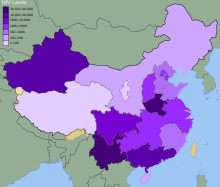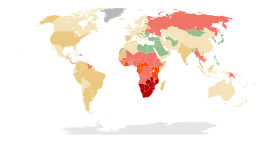HIV/AIDS in Asia
In 2008, 4.7 million people in Asia were living with HIV according to the United Nations (UN).[1] The UN believes that Asia's epidemic peaked in the mid-1990s, and annual HIV incidence has subsequently declined by more than half.[1] Regionally, the epidemic has remained somewhat stable since 2000.[1]
East Asia
Compared with other regions, notably Africa and the Americas, the national HIV prevalence levels in East Asia are very low (0.1% in the adult (15-49) group). However, due to the large populations of many East Asian nations, this low national HIV prevalence still means that large numbers of people are living with HIV.
China

The picture in this region is dominated by the People's Republic of China. Much of the current spread of HIV in China is through intravenous drug abuse and paid sex. In the rural areas, especially in Henan province, large numbers of farmers participated in contaminated blood transfusions; estimates of those infected are in the tens of thousands.
Japan
Official figures (English) for July–October 2006 showed that just over half of domestic HIV/AIDS cases were amongst homosexual men, with the remainder transmitted through heterosexual intercourse, drug abuse, in the womb or via unknown means. As of 2015, there have been a total of 17,909 HIV and 8,086 AIDS cases reported in Japan since 1985
North Korea
According to UNAIDS, less than 0.2% of North Korea's adult population has HIV.[2] WHO estimates that North Korea has less than 100 people with HIV/AIDS.[3] Officially, the country maintains that it is completely free of AIDS.[4]
South Korea
South Korea cumulative reported cases of HIV surpassed 6,000, and 797 reported in 2008.[5]
According to the Korea Centers for Disease Control and Prevention, the prevalence of HIV in South Korea is rising. The first case of HIV was in 1985 [6] In 2000, the number of people diagnosed with HIV was 219, and has risen to 797 diagnoses in 2008.[7] The majority of diagnoses were confirmed after routine check-ups, and males were found to have a much higher infection rate.[8] In order to prevent Korean women from contracting HIV, HIV positive males should be detected early on.[9] The most common transmission mode in South Korea is through heterosexual sexual contacts, because homosexuality is uncommon and socially unacceptable.[6]
Due to the lower prevalence of HIV in South Korea, the Korean media has represented HIV as a disease brought to Korea by foreigners from other countries.[10] The Korean government has created policies to incorporate these ideas. Any foreigners who plan to stay in South Korea must test for HIV, and if results show they are positive they are no longer able to stay in the country for any reason.[10] This may be a problem for foreigners who want to work in South Korea. The Korean government has also provided financial funding in order to reduce, and to assist those already living with the immunodeficiency virus for Korean citizens. Public Health organizations have created opportunities of assistance such as free treatment services, and anonymous testing locations.
Taiwan
As of March 2016, there are 31,620 reported cases of Taiwanese nationals testing positive for HIV/AIDS.[11] Currently HIV/AIDS patients who are Taiwanese nationals can enjoy free medical care (including HAART therapies), with the state covering the cost. Non-governmental organizations have set up "AIDS Half-Way Houses" for homeless patients. The ratio of patients of drug users increases rapidly, which has led the authority to promote a harm reduction program.
South and South-East Asia
This sprawling region is not just vast but diverse, with the nature, pace and severity of HIV epidemics differing across the region. The AIDS picture in South Asia is dominated by the epidemic in India, but new data released by UNAIDS shows that India as of 2007 has a relatively low Aids prevalence rate. With an estimated 2-3.1 million infections, India has the third largest number of people with aids after South Africa and Nigeria.[12]

In South and Southeast Asia, the HIV epidemic remains largely concentrated in injecting drug users, men who have sex with men, sex workers, and clients of sex workers and their immediate sexual partners. New infections are occurring in Thailand, Myanmar, and Cambodia at a steady rate. Prevention strategies in these populations are, for the most part, inadequate.
Bhutan
According to reports by Bhutan Ministry of Health, Bhutan had 246 reported cases of HIV/AIDS through August 2011.[14]
Cambodia
India
The AIDS picture in South Asia is dominated by the epidemic in India. In South and Southeast Asia, the HIV epidemic remains largely concentrated in injecting drug users, men who have sex with men, sex workers, and clients of sex workers and their immediate sexual partners.[15] Migrants, in particular, are vulnerable and 67% of those infected in Bangladesh and 41% in Nepal are migrants returning from India.[15] This is in part due to human trafficking and exploitation, but also because even those migrants who willingly go to India in search of work are often afraid to access state health services due to concerns over their immigration status.[15]
Indonesia
Malaysia
Malaysia for World AIDS Day 2008 reported 82,704 cumulative HIV cases since 1986 as of June 2008.[16]
Myanmar
Pakistan
HIV is not currently a dominant epidemic in Pakistan. However, the number of cases is growing. Moderately high drug use and lack of acceptance that non-marital sex is common in the society have allowed the AIDS epidemic to take hold in Pakistan, mainly among injection drug users, some male sex workers and repatriated migrant workers. AIDS may yet become a major health issue. The National AIDS Control Programme’s latest figures show that over 4,000 HIV cases have so far been reported since 1986, but UN and government estimates put the number of HIV/AIDS cases around 97,000 (range 46,000 to 210,000).[17] More realistic estimates that are based on actual surveillance figures, however, suggest that this number may be closer to 40,000 - 45,000. The overall prevalence of HIV infection in adults aged 15 to 49 is 0.1%[18] (and Shah et al. under review) (0.05% if one accepts the lower estimates).
Philippines
The Philippines has a relatively low incidence of HIV/AIDS. There have been about 2800 reported cases since 1984, but independent estimates put the number of cases closer to 12000.[19][20] The majority (70-75%) of carriers are male, 25-39, and the predominant mode of transmission is through sexual intercourse.
Although national incidence remains to be relatively low, an independent HIV surveillance study conducted in 2010 by Dr. Louie Mar Gangcuangco and colleagues from the University of the Philippines-Philippine General Hospital showed that out of 406 men having sex with men tested for HIV in Metro Manila, HIV prevalence was 11.8% (95% confidence interval: 8.7- 15.0).[21][22]
Singapore
The Ministry of Health maintains a confidential registry of HIV positive individuals. The private details of 8,800 foreigners and 5,400 Singaporeans infected with HIV were exposed as a result of improper handling of the data.[23]
Sri Lanka
Sex workers are considered most at risk. Number of partners per sex worker is comparatively low (4 per week) compared with other countries (Bangladesh 18-36 per week). There condom use rate is relatively high (67.6). Blood transfusion service is mostly state run and is considered safe. Of the 35,000 drug users less than 1% are thought to be injecting drug users.
Thailand
532,522 Thais were living with HIV/AIDS in 2008.[24]
Vietnam
The UN believes that there were approximately 290,000 people living with HIV as of 2008.[25]
See also
- AIDS pandemic
- HIV/AIDS in Africa
- HIV/AIDS in Europe
- HIV/AIDS in North America
- HIV/AIDS in South America
- HIV in Yunnan
References
- "Archived copy". Archived from the original on 2010-07-02. Retrieved 2010-10-21.CS1 maint: archived copy as title (link)
- "2006 Report on the global AIDS epidemic : A UNAIDS 10th anniversary special edition" (PDF). UNAIDS. 2006. p. 343. Archived from the original (PDF) on 2015-12-08. Retrieved 7 December 2015.
- "Young People and HIV/AIDS : Fact Sheet : DPR Korea" (PDF). Regional Office for South East Asia, World Health Organization. 20 November 2006. Archived from the original (PDF) on 8 December 2015. Retrieved 7 December 2015.
- O'Byrne, Tom (2 December 2001). "North Korea fights AIDS". ABC Radio National. Retrieved 2015-12-08.
- KaiserNetwork: Korea cases Archived 2009-06-23 at the Wayback Machine
- Oh, Myoung-don (December 1999). "Spectrum of Opportunistic Infections and Malignancies in Patients with Human Immunodeficiency Virus Infection in South Korea". JSTOR 4482066. Cite journal requires
|journal=(help) - Lee, Jin-Hee (December 2009). "Increasing Late Diagnosis in Hiv Infection in South Korea: 2000-2007". BIO MED CENTRAL.
- Lee, Jin-Hee (December 2009). "Increasing Late Diagnosis in Hiv Infection in South Korea: 2000-2007". BIO MED CENTRAL.
- Lee, Jin-Hee (September 2009). "Epidemiological Characteristics of HIV-Infected Women in the Republic of Korea: A Low HIV Prevalence Country". JSTOR 40542225. Cite journal requires
|journal=(help) - Cheng, Sealing (2004). "Interrogating the Absence of HIV/AIDS Interventions for Migrant Sex Workers in South Korea". JSTOR 4065354. Cite journal requires
|journal=(help) - "HIV月報105-03(更新)" (PDF). Centers for Disease Control, R.O.C (Taiwan). Retrieved 2 May 2016.
- "2.5 million people in India living with HIV, according to new estimates" (PDF). UNAids. Archived from the original (PDF) on 2007-09-30. Retrieved 2007-07-06.
- "AIDSinfo". UNAIDS. Retrieved 4 March 2013.
- "The Ministry of Health has Detected…". Bhutan Observer online. 2011-08-01. Archived from the original on 2011-10-28. Retrieved 2011-11-21.
- Fiona Samuels and Sanju Wagle 2011. Population mobility and HIV and AIDS: review of laws, policies and treaties between Bangladesh, Nepal and India Archived September 20, 2012, at the Wayback Machine. London: Overseas Development Institute
- HIV Cases On The Rise In Malaysia, Says UN Coordinator
- UNAIDS Epidemic update 2007 Archived 2008-10-02 at the Wayback Machine
- New government in Pakistan faces old challenges
- HIV and AIDS in Philippines,HIV in Philippines,AIDS in Philippines,social Indicators,social statistics, HIV Estimates,Figures,HIV situation in Philippines Archived 2008-05-10 at the Wayback Machine
- GMA NEWS.TV, RP HIV/AIDS situation alarming; undocumented cases at 11,000 - solon
- Gangcuangco, et al. Prevalence and risk factors for HIV infection among men having sex with men in Metro Manila, Philippines. "Archived copy" (PDF). Archived from the original (PDF) on 2013-10-14. Retrieved 2015-04-05.CS1 maint: archived copy as title (link)
- "Archived copy". Archived from the original on 2013-10-04. Retrieved 2013-10-02.CS1 maint: archived copy as title (link)
- https://www.businesstimes.com.sg/government-economy/data-of-14200-people-with-hiv-leaked-online-by-american-fraudstermoh
- More teenaged girls getting HIV infection Archived 2014-11-26 at the Wayback Machine
- "Archived copy". Archived from the original on 2010-07-03. Retrieved 2010-10-21.CS1 maint: archived copy as title (link)
External links
- AIDS epidemic update 2005 (PDF)
- Specific country data from UNAIDS
- AIDSPortal Asia page Latest research, case studies and news stories
- Aids Crisis in India Sapna Magazine Article
- AIDSPortal Central Asia page Latest research, case studies and news stories